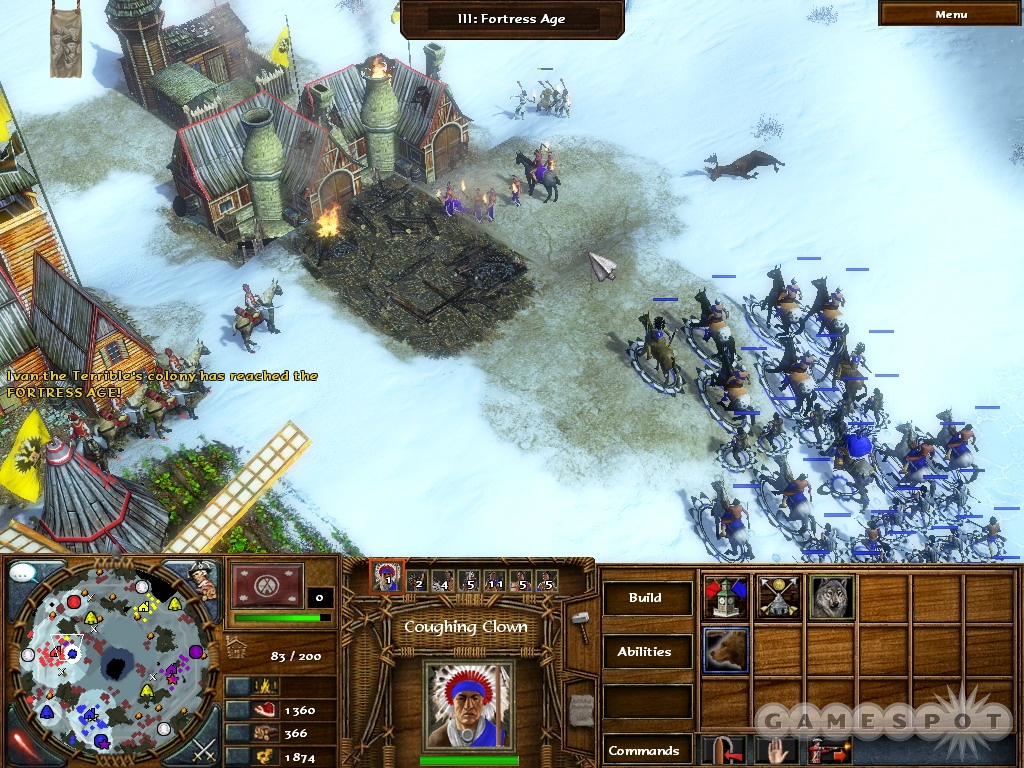When Age of Empires III arrived last year, it updated the famed real-time strategy series with gorgeous new visuals, though the sequel played it safe and offered only evolutionary improvements to the series' proven formula. You could take control of one of the great colonial powers during the Age of Discovery, which meant building villages to harvest resources and constructing forts, barracks, markets, walls, and more. Meanwhile, armies that consisted of militias, muskets, canons, and more tried to sweep the enemy factions off of the map. The overall experience ended up being very familiar to Age and real-time strategy veterans, though that didn't stop it from being fun and engaging.

Age of Empires III: The WarChiefs does its best to shake up that formula, even while it's sticking closely to it. This expansion introduces three new factions to the game, letting you play from the perspective of some of the Native American tribes in the New World. If you felt that the European civilizations were a bit too identical to one another in Age of Empires III, you won't get that sense with the Native American tribes. The most "conventional" of the tribes is the Iroquois because this tribe can bring its own artillery into the fray. Even then, nifty new features, such as a fire pit, differentiate it from the European factions. The fire pit is a huge bonfire to which you can assign dancers, and it also provides special powers, such as damage bonuses to your units or the ability to speed up the production of new villages. The more villagers you assign to the fire pit, the more powerful are the effects. Then there are the plains-dwelling Sioux, which specialize in horse units and allow you to conduct lightning-fast raids. It's easier to build up a large Sioux force compared to other factions thanks to the fact that the Sioux don't need to construct housing to raise the population cap. Finally, the Aztecs lack horses of any kind, but this powerful faction makes up for it with fast-moving and hard-hitting infantry units, such as the jaguar knight. Toss in the powerful new warchief hero unit, and these tribes can go toe-to-toe with the existing factions.
Many of the new gameplay adjustments in The WarChiefs are designed to destablize the current strategies for the game. The new revolution mode is a perfect example of just such a dynamic moment. Basically, if you get to a point in the game where you want to risk it all, you can declare a revolution. Then your villagers will turn into militia, and you get powerful new military units. The downside is that you lose all production capabilities after you declare revolution, so if you fail to crush your opponent with your forces, you'll lose big. The trade monopoly victory condition is another example of opening up the game. It forces you to get out and seize and hold trading outposts on the map in order to win; you simply can't sit back anymore behind the confines of your walls. There's also new content for the existing European civilizations, such as spies that let you observe the enemy safely.

The WarChiefs' campaign takes you on a brief tour of early American history. In it, you'll continue the Black family saga by fighting in the War of Independence and zooming ahead to Red Cloud's War, a Sioux uprising, shortly after the American Civil War. The campaign missions offer a mix of challenges, from having to scavenge food and supplies during the harsh winter at Valley Forge to establishing trading outposts in the rugged Montana wilderness. The missions are stitched together by short cutscenes, though the voice-over work and dialogue seem cheesy, especially after you hear General George Washington deliver lines that seem better fit for a B-grade action movie. Aside from the lackluster voice acting, though, the rest of the presentation is impressive. The sumptuous graphics of Age of Empires III still look great a year later, though there aren't any noticeable visual improvements. However, it's still fun to see the many ways that cannon fire can tear buildings and structures apart. Meanwhile, the Native American tribes also look visually distinct, especially when compared to the traditional look of the Europeans--from the Aztec's pyramid architecture to the tepees of the Sioux.
The WarChiefs expansion adds a solid amount of new content to the existing game, and while many of the new features provide interesting new ways to play and win the game, it's fair to say that fans of the series will appreciate the changes. The WarChiefs does a lot to shake up the formula, but when you get down to it, the tried-and-true Age of Empires gameplay remains pretty much intact, and the expansion offers more depth and strategy to an already deep strategy experience.